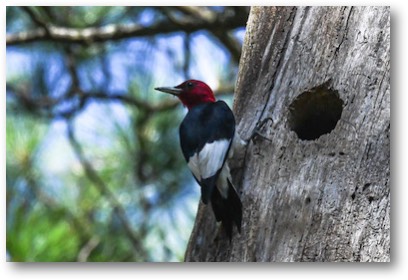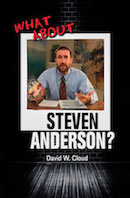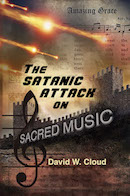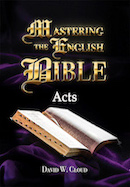866-295-4143, fbns@wayoflife.org

In flight the Red-headed woodpecker is a blur of brilliant color.
Its coloring has given rise to such nicknames as the flying checker-board, the flag bird, and the patriotic bird.
The Red-headed woodpecker is similar to the Pileated woodpecker, the red-bellied woodpecker, the Acorn woodpecker, Nutall’s woodpecker, the Yellow-bellied sapsucker, and the Red-naped sapsucker. But only the Red-headed woodpecker has an entirely red head.
The Red-headed woodpecker has been known to live 10 years.
The Red-headed woodpecker lives in central and eastern United States and southern Canada, and its habitat is relatively open woodlands, forests, pine plantations, and parks with standing dead trees. The population is decreasing due to habitat loss. The ones that live in Canada and northern parts of America migrate south in winter.
The Red-headed woodpecker eats a wide variety of things, including insects, spiders, worms, nuts, seeds, fruit, berries, even bark. It catches its prey in the air, in trees and shrubs, and on the ground. It has the amazing ability of catching insects on the fly. Its long, sticky, barbed tongue facilitates catching insets. It gathers acorns and nuts in the fall and stores them for winter. It even stores live grasshoppers by wedging them into crevices so tightly that they cannot escape. It covers the storage holes with bark to hide them.
Woodpeckers are designed to perch effortlessly on the side of trees. Their claws are sharp and dig into the tree. They have two toes pointing forward and two pointing backwards (most birds have three toes forward and one back). The woodpecker’s feet are especially tough and strong. In combination with its feet, the stiff tail spikes form a tripod for stability. “Woodpeckers have especially large tail bones, lower vertebrae, and muscles to support their tails, compared to other birds” (“17 Fun Facts,” Birdadvisors.com).
Woodpeckers are masterly designed to peck holes in wood, no small task for a bird that weighs only a couple of ounces. It hits the tree with 1000g of force without injury, whereas a football player can get a concussion from less than 100g of force. The woodpecker has special muscles at the base of the beak to act as shock absorbers, a small brain that fits tightly into a skull made of plate-like bones with a “spongy” structure at strategic locations, a hyoid bone that wraps around the entire brain cage and acts as a “seat belt,” a beak specially designed to absorb energy, an overall design that transfers 99.7% of the force of pecking to the bird’s body, a beak that constantly grows so that it is not worn out from the severe work, nostrils covered with special feathers and lined with bristles to filter out dust and tiny wood chips, and a nictitating membrane that closes over the eye a fraction of a second before its beak strikes wood, thus protecting the eye from debris, cleaning it, and conveniently keeping it from popping out of the creature’s head! The woodpecker’s amazing hearing allows it to hear the sound of insects and larvae moving and chewing inside wood.
Scientists are studying these created features (which some foolishly think “evolved”) to to improve the design of things such a helmets and car seats.
The Red-headed woodpecker is aggressive in defending its territory and nests from potential predators and visitors. It will even remove or destroy eggs in nearby nests.
The Red-headed woodpecker is solitary except for mating and nesting. Males group together to call to females with churrs, rattles, chatters, screeches, and drumming, and the females answer back with their own calls. A mating pair will often live monogamously for years and often use the same nest cavity each year. Breeding season is from April to August. For nesting, the pair use an existing hole or the male pecks out a new one assisted by the female. Apparently the female selects the location. “The female indicates acceptance of site by tapping on tree” (“Red-headed Woodpecker,” Audubon). Creating a new hole takes two to three weeks, and is a massive amount of work. The actual nest is about a foot below the entrance hole and is large enough to accommodate grown woodpeckers and chicks. The Red-headed woodpecker uses dead standing trees or dead limbs, and the nest is usually high up in the tree. The female lays from 3 to 7 eggs, and both parents incubate them (the male taking his turn at night) and both parents feed the nestlings. Some pairs hatch two broods in a season. The chicks leave the nest in about a month.
What is the purpose of the Red-headed woodpecker? God made it for man’s pleasure and education and for the environment and for God’s glory. This fascinating little bird teaches us all sorts of thing, such as these: God is an omnipotent, omniscient Creator who can conceive of, design, and make such a creature. God is a God of beauty and order. God loves man and has provided him with every sort of blessing. The fact that the female woodpecker is as beautiful as the male reminds us that both male and female of mankind are made in the image of God, and the female is the glory of the male. The fact that they mate monogamously reminds us that God designed marriage for life. The fact that they often produce two broods in a season reminds us that God has commanded man to be fruitful and multiply.
For more about the amazing woodpecker, including why his pecking doesn’t harm his brain, see “The Woodpecker’s Design” at www.wayof.life.org.
- Receive these reports by email
- www.wayoflife.org
______________________
Sharing Policy: Much of our material is available for free, such as the hundreds of articles at the Way of Life web site. Other items we sell to help fund our expensive literature and foreign church planting ministries. Way of Life's content falls into two categories: sharable and non-sharable. Things that we encourage you to share include the audio sermons, O Timothy magazine, FBIS articles, and the free eVideos and free eBooks. You are welcome to make copies of these at your own expense and share them with friends and family. You may also post parts of reports and/or entire reports to websites, blogs, etc as long as you give proper credit (citation). A link to the original report is very much appreciated as the reports are frequently updated and/or expanded. Things we do not want copied and distributed are "Store" items like the Fundamental Baptist Digital Library, print editions of our books, electronic editions of the books that we sell, the videos that we sell, etc. The items have taken years to produce at enormous expense in time and money, and we use the income from sales to help fund the ministry. We trust that your Christian honesty will preserve the integrity of this policy. "For the scripture saith, Thou shalt not muzzle the ox that treadeth out the corn. And, The labourer is worthy of his reward" (1 Timothy 5:18). Questions? support@wayoflife.org
Goal:Distributed by Way of Life Literature Inc., the Fundamental Baptist Information Service is an e-mail posting for Bible-believing Christians. Established in 1974, Way of Life Literature is a fundamental Baptist preaching and publishing ministry based in Bethel Baptist Church, London, Ontario, of which Wilbert Unger is the founding Pastor. Brother Cloud lives in South Asia where he has been a church planting missionary since 1979. Our primary goal with the FBIS is to provide material to assist preachers in the edification and protection of the churches.
Offering: Offerings are welcome if you care to make one. If you have been helped and/or blessed by our material offerings can be mailed or made online with with Visa, Mastercard, Discover, or Paypal. For information see: www.wayoflife.org/about/makeanoffering.html.





